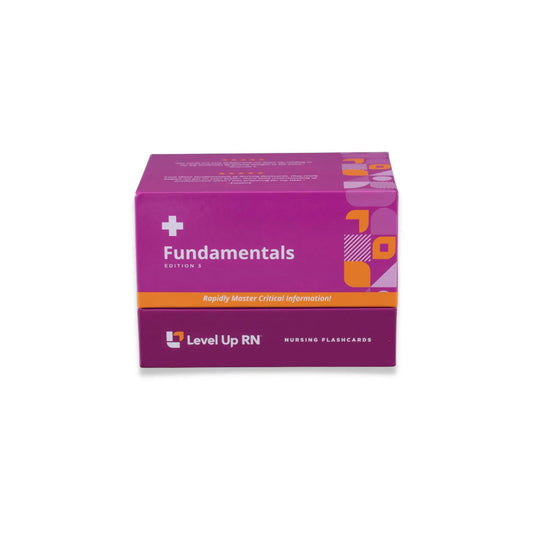Fundamentals of Nursing - Flashcards
This article covers enteral and parenteral nutrition. You can follow along with our Fundamentals of Nursing flashcards, which are intended to help RN and PN nursing students study for nursing school exams, including the ATI, HESI, and NCLEX.
Enteral nutrition
Enteral nutrition is a method of artificial nutrition where a patient obtains nutrients via their GI tract (by mouth or feeding tube). “Enteral” has the same root word as “gastroenteritis” — “entero” means “referring to the GI tract.” In this situation, we are still delivering nutrition to the GI tract, and the GI tract is still processing the nutrients, but the patient is not eating the food in their mouth and swallowing it.
Enteral nutrition is a preferred option when it is important to keep the GI system functioning — including maintaining gastric motility (the process of food traveling through the digestive tract) and peristalsis.
Peristalsis is the contraction of the stomach muscles and other muscles in the GI tract that move food along, which allows for digestion. Less peristalsis means less gastric emptying, and this can contribute to nausea and vomiting, constipation, and heartburn.
Enteral nutrition is indicated for disorders that prevent oral nutrition (e.g., dysphagia, coma, upper GI obstruction, severe anorexia, malnutrition).
Types of enteral feeding tubes
There are two types of enteral feeding tubes depending how long (duration) they must be used.
Nasogastric tubes are indicated for short-term use. As discussed in the previous blog post, NG tubes can be irritating to the nose and the esophagus over time; they can even cause different types of pressure injuries.
For longer-term use (e.g., more than four weeks), a percutaneous endoscopic gastrostomy (PEG), or surgically placed gastrostomy tube, is necessary.
Percutaneous, means through the skin. A percutaneous tube could include a PEG tube, a G-tube, or a GJ-tube.
Difference between a G-tube and a GJ-tube
A G-tube (gastrostomy tube) gives liquid nutrition, medication, and other fluids directly into the stomach. A GJ-tube (gastrojejunostomy tube) gives liquid nutrition, medication and other fluids directly into the small intestine (the jejunum).
Continuous vs. intermittent feeding
When administering enteral nutrition, there are two options: continuous feeding and intermittent feeding.
Continuous feeding is when nutrition is delivered down the line via pump.
Intermittent feeding is delivered via gravity, pump, or bolus feeding with a syringe.
Note that when increasing the feeding rate, do this slowly until the ordered rate is achieved (per facility policy).
Tube feeding best practices
Before feeding, perform an abdominal assessment and confirm the presence of bowel sounds (to make sure everything is functioning).
Elevate the head of the bed 30° – 45° during feeding and for at least an hour after feeding. This is to reduce the risk of aspiration.
Remember, the only way to confirm that a nasogastric tube is in the correct place is with an abdominal X-ray. Next, measure the length of the exposed NG tube and confirm that it matches the previously documented length (to ensure the tube is inserted fully). Then verify the pH of aspirated contents by aspirating fluid and testing the pH. The gastric environment is highly acidic, so if the tube is correctly inserted in the stomach, a pH test on the aspirated fluid will be less than 5.5 (indicating an acidic environment).
Never instill air into the tube to check its placement. Use the combination X-ray and pH test to confirm proper placement.
Measuring the gastric residual volume (GRV)
An additional task is to aspirate (pull out) all gastric contents with a large syringe before starting a feed to measure the gastric residual volume (GRV). This is in order to measure how much is left in the stomach when it’s time for the next feed. Using this GRV measurement will indicate if it is necessary to alter the frequency of the feeds, or it might indicate that there is a GI problem.
Note that the protocols for this step may vary depending on the facility’s policy (or textbook), but generally, if the GRV is more than 500 mL, the contents are not returned to the stomach and it is necessary to call the provider. For GRVs less than 500 mL, those contents may be returned to the stomach.
Other best practices when administering a feeding tube
Flush the tube with 30 mL water before and after feeding, medications, GRV check, or every 4 hours during continuous feeding
Change delivery sets (e.g., bag and tubing) every 24 hours or per facility policy. This is to prevent microbial growth.
Clean the opening and rim of formula cans before using them, and refrigerate any opened cans that still have formula in them. Discard these opened cans after 24 hours (again, to maintain infection control).
To prevent bacterial growth, limit hang time to 4 hours for open systems and 24 – 48 hours for closed systems (or per manufacturer guidelines).
The National Institutes of Health defines an open system as one that includes ready-to-use cans and powdered or sterilized formulas that require reconstitution with water. A closed system, or ready-to-hang (RTH) system, is a completely closed non-air-dependent collapsible bag system requiring minimal handling and minimal manipulations.
Parenteral nutrition
Parenteral nutrition (or total parenteral nutrition, “TPN”) is nutritional support administered through a central line. The prefix “para-” means “around,” so in this nutrition delivery system, the nutrition goes around the GI tract, circumventing or avoiding it.
Check out our medical terminology deck to learn more of these roots — where they derive from and what they mean. The Medical Terminology and Abbreviations Flashcards allow students entering in or currently enrolled in a healthcare-related program to build a strong foundation of medical terminology and abbreviations.
Parenteral nutrition is delivered into the vascular space, i.e., directly into the bloodstream. Note that a central line — either a PICC line or a central venous catheter— must be used, not a peripheral IV.
Parenteral nutrition is indicated for malabsorption (a condition that prevents absorption of nutrients through the small intestine), hypermetabolic state (which can lead to extreme weight loss), malnutrition, and prolonged NPO (fasting).
Nursing care
Have a second nurse verify the TPN bag label and prescription to confirm the correct bag/prescription is being used.
Once parenteral nutrition has begun, gradually increase or decrease flow rate as needed.
Monitor I&Os, daily weights, and electrolyte levels.
It is especially important to monitor glucose levels to ensure the patient is getting enough (but not too little or too much).
You can learn about blood glucose labs and more with our Lab Values Study Guide & Flashcard Index, a list of lab values covered in our Lab Values Flashcards for nursing students, an easy reference guide.
Use IV tubing with a filter, and change the tubing and bag every 24 hours to prevent bacteria growth.
If the next TPN bag is unavailable for a timely exchange, it is important to continue to give the patient glucose. In the event of a late-arriving replacement TPN bag, administer 10% – 20% dextrose/water until it arrives. (This may vary depending on the orders or facility policy.)
Do not administer other fluids or meds through a TPN line.
Monitor the central line insertion site for signs or symptoms of infection or infiltration.


